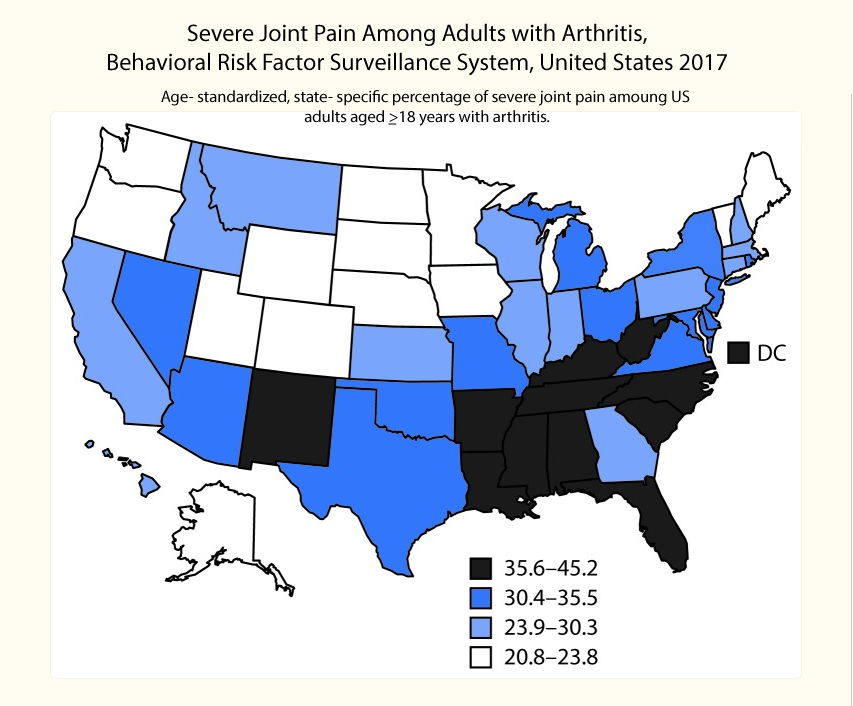Prevalence and Risk Factors for Arthritis
Arthritis-related severe joint pain affects adults of all ages, both sexes, and all races and ethnicities. According to the CDC, the age-standardized prevalence of severe joint pain among adults with arthritis varies by state, ranging from 21% in Colorado to 45% in Mississippi.
In 2017 in the United States, severe joint pain prevalence among adults with arthritis was:
- Higher among women (36.0%) than men (27.3%)
- Highest among adults aged 45 to 64 years (35.6%). Prevalence was next highest for adults aged 18 to 44 years (33.0%) and lowest for adults aged 65 years or older (25.1%).
- Highest among non-Hispanic Blacks (50.9%), followed by Hispanics and American Indian/Alaska Natives, (both 42.0%), then Other/Multiple Races (37.4%) and Asians (27.7%), and lowest among non-Hispanic whites (27.4%).
- Highest among obese (37.2%) compared to overweight (28.6%) and underweight adults (29.1%).
- Severe joint pain is more common among adults with arthritis who also have other chronic conditions including diabetes (40.9%) and heart disease (34.1%), and among adults with a disability (45.6%).
- More than half (56.3%) of adults with arthritis and serious psychological distress reported having severe joint pain.

Risk Factors for Arthritis
Arthritis is common; in fact, about 1 in 4 US adults have arthritis. Some behaviors and characteristics, called risk factors, increase your likelihood of getting some types of arthritis or making it worse. You can control some risk factors, and others you cannot.
Risk Factors You Can Control
Modifiable risk factors are risk factors that you can control. Making lifestyle changes can decrease your risk of getting some types of arthritis or making arthritis worse.
Overweight and Obesity
Extra weight puts more stress on joints, especially the knees and feet. People who are overweight or obese are more likely to get knee osteoarthritis than people who are not overweight. Excess weight can also make knee osteoarthritis worse. Extra weight puts more stress on joints, particularly weight-bearing joints like the hips, knees, and ankles.
What you can do: Maintain a healthy weight. Healthy eating and physical activity can help you lose weight and stay at a healthy weight. Focusing on eating fruits and vegetables for every meal and snack, choosing whole grains, and limiting added sugars are 3 ways to make a big difference in your health through your diet.
Joint Injuries and Infection
Joint injury or overuse and repetitive stress can damage a joint and contribute to the development of osteoarthritis. Infection is another concern. Many microbial agents, like bacteria and viruses, can infect joints and potentially cause the development of some types of arthritis.
What you can do: Protect your joints from injuries by exercising safely. If a joint is warm, red or swollen, see your doctor right away to check for infection.
Occupation
Occupations that involve repetitive movements, heavy lifting and carrying, ladder climbing, or holding your body in a bad ergonomically acceptable position are associated with joint pain and osteoarthritis.
What you can do: Make sure your worksite is free of fall hazards and has the space, equipment, and tools that fit your physical ability and limitations. Learn about ergonomics and make sure to focus on lifting and moving safely.
Smoking
Cigarette smoking increases a person’s risk of developing rheumatoid arthritis (RA) and can make the disease worse. It can also cause other medical problems. Smoking can also make it more difficult to stay physically active, which is an important part of managing RA and other types of arthritis.
What you can do: Stop smoking. Talk with your doctor to discuss options for smoking cessation and seek support to help you through the process.
Risk Factors You Cannot Control
Non-modifiable risk factors are risk factors that you cannot control. These include:
Age
Your risk for most types of arthritis increases as you get older due to wear and tear of your joints and the natural degradation of cartilage as you age.
Gender
Most types of arthritis are more common in women, including osteoarthritis (OA), rheumatoid arthritis (RA), and fibromyalgia. Gout is more common in men. Experts don’t know exactly why women are at higher risk for developing most types of arthritis, or why men are at higher risk for developing gout.
Genetics and Inherited Traits
People born with specific genes are more likely to develop certain types of arthritis, such as rheumatoid arthritis (RA), systemic lupus erythematosus (SLE), and ankylosing spondylitis. These genes are called HLA (human leukocyte antigen) class II genotypes and can also make your arthritis worse. Experts do not know why people with these genes are at higher risk for developing arthritis or why it can make their arthritis worse.
